Which material is better
Some time ago it was incredible to buy a stainless steel sink. Enameled ones were mainly used. The idea isn’t bad, of course, but the execution was extremely poor. Today there are sea alternatives:
- Stainless steel: It may or may not be polished. The most durable option, easy to clean. However, the polished stainless steel sink will eventually become covered in a network of scratches and lose its appearance. Unpolished looks good but costs more. Well, the main drawback is the noise when the water jet falls. To make the sink “quieter”, a layer of soundproofing material is glued from below.
- Copper: These are not cheap options. Suitable for special kitchen interiors. Difficult to care for (special products required) and are not widespread.
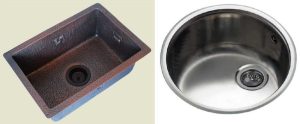
- Made of artificial stone: The natural component (stone chips and quartz sand) is diluted with a polymer binder, and the resulting composition is poured into molds. This is how a stone sink is made. There are different types of sink materials: based on granite, quartz, marble, and quartz sand. They are usually called by the “stone” component: granite, marble, and quartz sinks for the kitchen: Some companies develop special compositions, but they differ in a polymer binder, which gives the product certain performance characteristics (for example, Silgranit from the German company Blanco).
- Ceramics: Ceramics – porcelain or earthenware – are not so popular for sinks, but they are also there.
Some appeared not so long ago – with a glass panel (pictured left). This is a stainless steel sink with a tempered glass surface. This option looks good next to a pour of the same color. And don’t be afraid of the glass breaking. It has been hardened so it is difficult to damage it.
Stainless steel or stone?
It is usually difficult to decide which is better: a stainless steel sink or a stone sink. First, let’s talk about the benefits of each type. Stainless steel is not afraid of shocks, washes well, and is used for a long time. Stone kitchens are quiet, and can have different colors, and a wider range of shapes.
Now about the cons. Stainless steel: noisy, there are only two options for “colors”, polished scratches and it is impossible to remove scratches. With a high salt content in the water, stains remain on the polished surface. So, to make the sink look nice, you need to take care of it. Cheap stone chip sinks require careful handling: scratches and chips may occur. Some – bright – may turn yellow or darken over time. Cleaning can solve the problem, but it can be worrisome. If the content of stone chips or quartz is low, the artificial stone may sink, being afraid of high temperatures. So that you don’t care, just make sure the quality of the product is normal.
How critical are chips and scratches on granite sinks
You should not drop anything heavy in them. No, nothing comes from a dropped cup or plate. The counter will break and the sink will likely remain as it was. A small chip may appear – it depends on how and where it falls. However, if you drop a heavy pot or pan, you can expect a chip with a high probability.
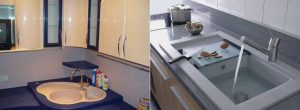
The good news is that scratches can be sanded out. For this, sometimes the abrasive part of the sponge is enough, and sometimes it is necessary to take sandpaper with a fine grain. The degree of sanding depends on the quality of the material from which the sink is made. If the composition is colored in the mass (the dye was added before casting), it can be sanded to any depth.
Chips on granite, quartz, and other composite sinks are also easy to remove. Most companies have “repair kits”. It is a pigment in powder form and a polymer binder. By mixing a certain amount, you get a repair compound. It is applied to the place of the chip, and after drying it is sanded. Often the previous chip has to be searched for a long time and you may not find it.
Lower forms
Choosing a sink for the kitchen is far from easy. There are so many offers that it’s easy to get lost. The species diversity plunges into a stupor. Sometimes even the shape is not so easy to determine, but the shape of the kitchen sink is:
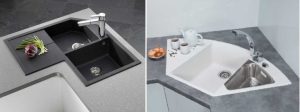
- Corner: The best option for L- and U-shaped kitchen sets. By installing the sink in a corner, you can make the best use of this space.
- Rectangular / square: The most common because they allow you to use the area optimally. It is convenient to wash dishes in any format in them. Same baking sheets, skewers, etc.
- Round: They seem to be the most original, but in practice they are inconvenient – the problem is washing the baking sheet and other large dishes because they are much smaller in size than the bowl. Models without a table look from the side, maybe not bad, but very uncomfortable. In models with a wing, it is usually small, which also helps a little.
- Oval: Rarely enough. Most often it is a round sink, complemented by a second bowl or table next to it. The shape of the “wing” is just oval. And the oval sink is extremely rare.
There is also such a type as modular kitchen sinks. They are made of artificial stone and cast immediately with the countertop. This look is made to fit your size, so local businesses make it. It is difficult to say how high quality the product will be – it depends on the specific company.
If we talk about choosing a shape, after all, more often they stop at rectangular or square. Besides being a classic, they are the most practical to use.
Only here and rectangular can be with more or less rounded corners. Sharp corners look more graphic, but they are more difficult to clean – it is more difficult to clean away the dirt that accumulates there.
Bowls and their varieties
Sometimes the size of the sink is very important – in small kitchens, narrow countertops. In this case, a sink with sides is usually used. It is just a bowl, along the circumference or around the circumference where there is a thickening or a ledge – aside. The side width is several centimeters.
The second type is a sink with a work surface – a wing to the right or left of the bowl. Some models are “reversible”, that is, they can be installed either way. Also called “sink with a wing”. They are interesting in that you can lay out the washed dishes on the surface to empty, leave food, etc. The dripping liquid enters the sink.
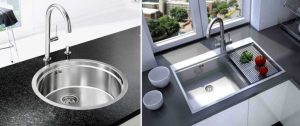
Sink with two bowls. And there are two options:
- both bowls are the same size (can be called double sinks).
- one bowl is larger, the other is noticeably smaller (in size and/or depth).
Two identical bowls can be used for faster washing of dishes: soapy water in one bowl, and clean water in the other for rinsing. The second option is also called a half-and-half sink. The second – a smaller vessel is used to thaw food, squeeze out excess liquid, etc. In a shallow bowl, you can put a grid (called a colander), which increases functionality.
There are also sinks for the kitchen with two bowls and a “wing”. They are good for large kitchens. In principle, they can be used both under a window and on a long work wall.
Read another article about Types of Kitchen Sinks
Installation method
There are three ways to install a kitchen sink on a countertop:
- Mortice. This is when a bowl-shaped cutout is made on the countertop, a sink is inserted into it. It is held by the sides, although there are additional fasteners.
- Installation under the table. Sinks that are attached to the bottom of the countertop. The cutout in the tabletop is made strictly according to the size of the bowl. In addition, the board must be processed ( edged or sanded if the worktop is made of artificial stone).
- Flush with the countertop. This is how only certain types of sinks are installed. In principle, you can put a regular sink, but for this, you have to mill a groove on the countertop. And this must be done very precisely.
It is necessary to choose the sink installation method for the countertop even before deciding on the model. For each installation, there are its versions, and its fasteners, which come with the sink.
Sink dimensions
Since the sink is installed on the top of the cabinet, it cannot be larger than that. Note that it is very difficult to find options in cabinets with a shallow depth – of less than 60 cm. Unless the sink is only one edge and for surface mounting.
When choosing a specific model, you must first know the distance between the front and back walls of the cabinet, and the dimensions of the tabletop. Why do both? Because the countertop is usually larger than the cabinet. In this case, the cutout in the tabletop should be at some distance from the walls of the frame. For mounting and installation under the table at the level of to track such parameters:
- The optimal distance from the back and front walls of the cabinet is 5 cm. The distance from the back can be greater – it will be more convenient to keep it clean. With a large enough gap between the sink and the wall, you can install household chemicals, preferably choosing a dispenser to keep everything you need close at hand.
- You can also put your sink flush with the back edge of the countertop, but cleaning will be more difficult.
- It is not worth moving the sink from the front edge of the countertop far inward – it will be inconvenient to use. But too close is not so good either – clothes get wet from splashes.
If you are thinking of buying a sink with two bowls or one with a drain, you also need the length of the sink. Most often they cut it symmetrically about the middle, but this depends to a greater extent on the position of the furniture.
If you are more satisfied with the installation (built-in, recessed), it is better if the sink has the same dimensions as the worktop. If this cannot be achieved and the difference in depth is small, the entire gap remains either in front or behind. “Split” makes sense when the difference in width is more than 8 cm.
Generally speaking, the standard is a square sink measuring 500 * 500 mm or 600 * 600 mm. Not everyone can install them in our apartments. Therefore, there are narrower sinks for small kitchens – from 400 mm. But they are mainly for mounting under the table, although there are also overhead ones.
Bowl depth
In addition to the size of the sink, you must also choose the depth of the bowl. The optimal depth is 17-19 cm. Smaller models are not so practical – water is sprayed. There are also deeper ones – up to 25-26 cm. They are intended for cafes and restaurants, where there are many dishes and the size of pots/vessels is much larger. However, if you use large cookware, you may be more comfortable with this option.
If you decide to install a small round bowl, be prepared that they will all be 20 cm deep or more. Smaller ones are hard to find – only Chinese.
How to choose a sink for the kitchen
Regardless of what you have chosen – a stainless sink or stainless steel, you need to look for decent options in its class. To do this, you need to know how a good car wash differs from a bad one.
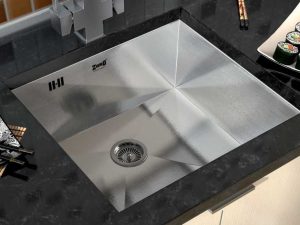
Signs of quality granite (marble, quartz) sinks
As mentioned earlier, an artificial stone sink consists of stone chips (sand) and a polymer binder. So that the surface is not scratched, and chips from weak impacts do not appear. The composition must contain 80% of a natural component (stone or sand). The remaining 20% is a binder. It must be sustainable, and must not contain substances harmful to humans. With this composition, the material can withstand heating up to 280 ° C. Pouring boiling water or even boiling oil into the sink is safe.
But even granite sinks of very high quality can be scratched. Stuff happens. For elimination (mechanical sanding with sandpaper) to be problem-free, the composition must be dyed in bulk. This means that the color pigment is added during mixing. In this case, its consumption is much higher, which increases the price of the product. But there are no limitations when grinding. And chips and scratches are only visible up close.
In addition, many manufacturers introduce additional components or develop new technologies that facilitate operation and provide new features:
- Antibacterial effect. At the factory in Plados, Triclosan is added and silver ions are added to German Schock shells.
- Dirt-resistant coating. Some Blanco stone sinks have this effect. It is much easier to wash them.
- Increased durability. The Italian company ELLECI has developed a new formulation containing glass granules.
All these additives add value to the product. However, the new features do not seem unnecessary or unnecessary at all. You can even combine everything.
High-quality stainless steel sink
First of all, they pay attention to the metal itself. And that’s right. Good stainless steel contains a sufficient amount of alloying metals: 18% chromium and 10% nickel. Such a composition gives the metal the necessary strength, and durability and guarantees the absence of signs of destruction for decades.
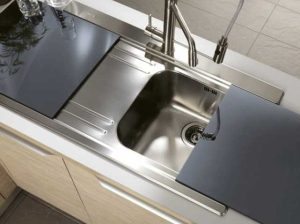
An important indicator is the thickness of the metal. The optimal thickness is from 0.9 mm to 1.2 mm. Cheaper can be 0.6-0.8 mm. If the steel is good, it does not greatly affect the service life. Manufacturers known for their quality also have metal sinks of this thickness. As a rule, lines with a lower price are made of thin stainless steel.
Very dubious sinks claim that the thickness of stainless steel is 2 mm. If their price is not high, most likely the percentage of alloyed metals is very small and does not correspond to the declared one.
More reliable are stainless steel kitchen sinks with a bowl that is welded to the base. It is only important that the welding is carried out in a protective environment. This technique avoids thinning in places with sharp bends, which is typical for punched products (squeezed out of the sheet during the press). Although such can live long enough. But their models are simpler.
Read another article about Choosing the right sink for the kitchen
Manufacturer
If you want the sink to serve for a long time, it is better to choose products from reliable manufacturers. They usually produce both artificial and stainless steel sinks. But not everyone. Stone sinks from the following companies have been on the market for a long time and have received good reviews:
- SCHOCK, Blanco (Germany)
- ASTRACAST (England)
- Alveus (Slovenia)
- PLADOS and ELLECI (Italy)
The quality of the sinks from these companies does not leave any questions, but not everyone can pull the price. If you need a more budget option, pay attention to the products of domestic manufacturers – Polygran (POLYGRAN) and GranFest (Granfest). Quite a worthy replacement. Just keep in mind – they are not entirely made of artificial stone. Outside there is a layer of resin and stone, below – plastic. That’s why they are so cheap. But at a fairly modest price, they serve 7-8 years without complaints. If this option suits you, why not?
Many of the above have stainless steel kitchen sinks. You can add some more names to them:
- Concern
- Arrive
- Sailor
The latter two have slightly more modest prices, which does not affect the quality. You can also pay attention to Belarusian car washes. You won’t be able to find super-refined models, but the classics and a certain set of variations are of very good quality.

Leave a Comment